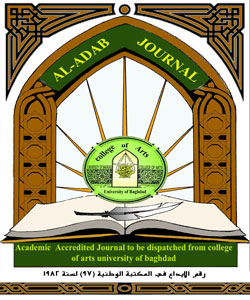The impact of demographic factors of the population of hotspots on crime in the UAE Society
Emirate of Sharjah as a Model
DOI:
https://doi.org/10.31973/4vxt9v22Keywords:
Hotspots, disturbing crimes, feeling safeAbstract
The study aims to identify the concept of crime and hot spots and to identify the classification of crimes in the United Arab Emirates and what is its impact on the society of the Emirate of Sharjah. It shows the nature of the relationship between crime and hot spots and what dangers they pose to society. Presenting results, solutions and proposals that enable the security services and the Sharjah Police General Command to work on them to control hot spots and protect society from them. To achieve the objectives of the study, the analytical descriptive approach was used, using the questionnaire as a tool for the study, and it consists of (39) items distributed on four dimensions. The study sample consisted of (507) people who were chosen randomly. The results showed a clear effect of the personal variables represented in the area of residence, the nature of presence, gender and nationality on the four axes of the study: the sense of security, the seriousness of crime, the impact on business, and ways to address crimes. The study reached a number of recommendations, the most important of which are: intensifying efforts related to reducing crimes committed in hot spots, as well as the importance of having cameras in the streets and public places, and the presence of an advanced electronic system in public places for surveillance purposes, as well as the availability of sufficient lighting in places of residence and work, and then developing security initiatives. Innovative to reduce crime in order to confront crimes in hot spots.
Downloads
References
خلفان، ضاحي. (2016). الجريمة، دبي ، حكومة دبي .
النيابة العامة، دبي ،حكومة دبي، ٢٠٢٢.
وزارة الداخلية (2022). وثيقة الخطة الاستراتيجية لوزارة الداخلية.، الادارة العامة للتخطيط الاستراتيجي، وزارة الداخلية
وزارة الداخلية.( 2023). التقرير الاحصائي للجرائم المقلقة، الادارة العامة للإدارة العامة للعمليات الشرطية. وزارة الداخلية
كريستين سلرز ورونالد اكرز (2013). نظريات علم الجريمة: المدخل والتقييم، والتطبيقات ترجمة ذياب البداينة ورافع الخريشة. عمان، دار الفكر.
Braga, Anthony A. (2006). The Crime Prevention Value of Hot Spot Policing, Psicothema. Vol. 18, nº 3, pp. 630-637.
Braga, Anthony A. (2008). Police Enforcement Strategies to Prevent Crime in Hot Spot Areas, U.S. Department of Justice- Office of Community Oriented Policing Service
John E., Spencer C., James G., Michael L., and Ronald E. (2005). Mapping Crime: Understanding Hot spots, National Institution of Justice.
Merigan, Heather L. (2013). Hot Spot Policing and Use of Crime Prevention through Environmental Design, Heat, Regis University
Marcus Felson and Mary Eckert (2019). Introductory Criminology: The Study of Risky Situations, Taylor & Francis Ltd.
Ronald L. Akers, Christine S Sellers, and Wesley G. Jennings (2020) Criminological Theories: Introduction, Evaluation, and Application, Oxford university Press. ISBN: 978019093525, Eighth Edition.
Downloads
Published
Issue
Section
License
Copyright (c) 2024 سعود محمد بيات، أ.د. أحمد فلاح العموش، د. آلاء الطائي

This work is licensed under a Creative Commons Attribution 4.0 International License.
Copyright and Licensing:
For all articles published in Al-Adab journal, copyright is retained by the authors. Articles are licensed under an open access Creative Commons CC BY 4.0 license, meaning that anyone may download and read the paper for free. In addition, the article may be reused and quoted provided that the original published version is cited. These conditions allow for maximum use and exposure of the work.
Reproducing Published Material from other Publishers: It is absolutely essential that authors obtain permission to reproduce any published material (figures, schemes, tables or any extract of a text) which does not fall into the public domain, or for which they do not hold the copyright. Permission should be requested by the authors from the copyrightholder (usually the Publisher, please refer to the imprint of the individual publications to identify the copyrightholder).
Permission is required for: Your own works published by other Publishers and for which you did not retain copyright.
Substantial extracts from anyones' works or a series of works.
Use of Tables, Graphs, Charts, Schemes and Artworks if they are unaltered or slightly modified.
Photographs for which you do not hold copyright.
Permission is not required for: Reconstruction of your own table with data already published elsewhere. Please notice that in this case you must cite the source of the data in the form of either "Data from..." or "Adapted from...".
Reasonably short quotes are considered fair use and therefore do not require permission.
Graphs, Charts, Schemes and Artworks that are completely redrawn by the authors and significantly changed beyond recognition do not require permission.
Obtaining Permission
In order to avoid unnecessary delays in the publication process, you should start obtaining permissions as early as possible. If in any doubt about the copyright, apply for permission. Al-Adab Journal cannot publish material from other publications without permission.
The copyright holder may give you instructions on the form of acknowledgement to be followed; otherwise follow the style: "Reproduced with permission from [author], [book/journal title]; published by [publisher], [year].' at the end of the caption of the Table, Figure or Scheme.











